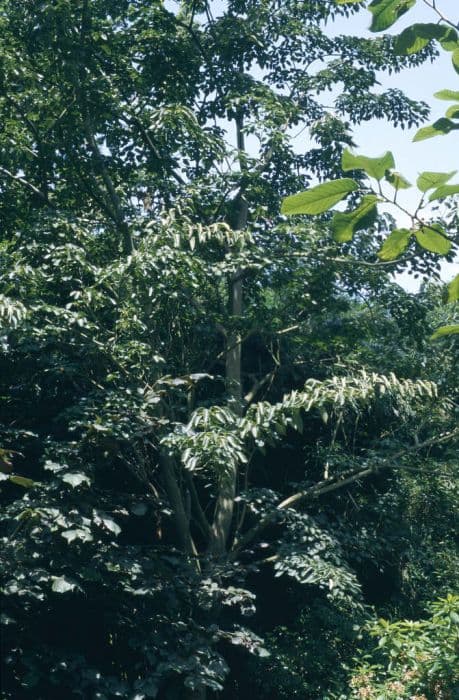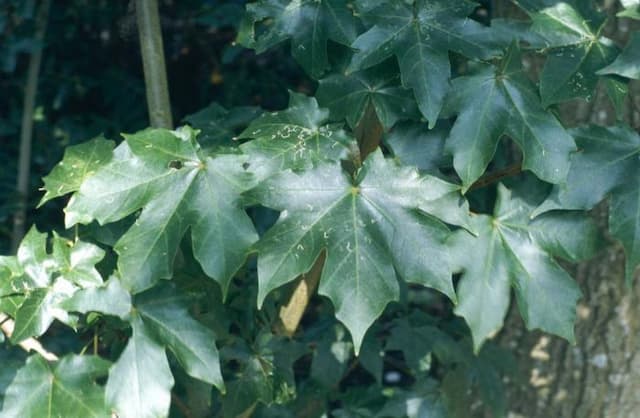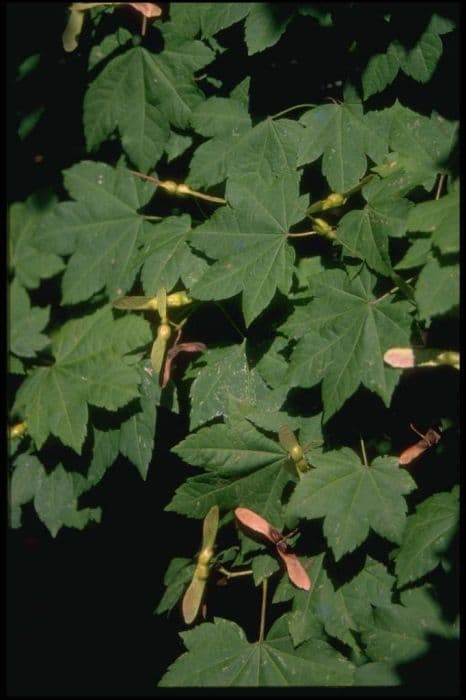Japanese Maple Acer palmatum 'Burgundy Lace' (M)

ABOUT
Acer palmatum 'Burgundy Lace', commonly known as Burgundy Lace Japanese Maple, is a striking ornamental tree that garners attention with its distinctive foliage and captivating colors. During the growing seasons, its leaves present in fine lacy patterns, with each leaf exhibiting deeply dissected and serrated margins that enhance its delicate appearance. The leaves are arranged in a palmate fashion, radiating from a central point much like the fingers spreading from the palm of a hand, hence its name. The appearance of the Burgundy Lace Japanese Maple is characterized by its beautiful foliage colors that change throughout the year. In spring, the new leaves emerge a bright reddish-purple, providing a vivid burst of color in the landscape. As the seasons transition into summer, the leaves mature to a deeper burgundy hue, which maintains its vibrancy under the full sun or part shade environments where these trees often thrive. Come fall, the tree puts on yet another show as the foliage transforms into a medley of fiery colors. The leaves may take on shades of crimson, red, and orange, creating a spectacular autumn display. The color changes are influenced by a variety of factors, including temperature, light levels, and the tree's genetic makeup. The Japanese Maple's overall form is equally graceful, often exhibiting a rounded or slightly weeping habit that adds to its ornamental value. The branches are elegantly spread, providing a layered structure to the tree which further accentuates its delicate leaf patterns. The tree's bark is relatively smooth, with a subtle texture that complements its refined appearance. Burgundy Lace Japanese Maples are widely appreciated for their aesthetic appeal in garden and landscape settings. Their dramatic foliage and pleasing form make them ideal focal points in a variety of planting designs, whether as standalone specimens or integrated into borders and plant groupings. It should be noted, though, that the plant's ornamental character is achieved without reference to its size.
About this plant
 Names
NamesFamily
Sapindaceae
Synonyms
Japanese Maple, Burgundy Lace Maple, Threadleaf Japanese Maple
Common names
Acer palmatum 'Burgundy Lace'
 Toxicity
ToxicityTo humans
Japanese maple is not known to be toxic to humans. Consequently, ingesting parts of the plant typically does not lead to poisoning or adverse health effects.
To pets
Japanese maple is generally considered non-toxic to pets, including cats and dogs. Ingesting its parts should not cause poisoning or serious consequences for your pets. However, ingestion of any plant material may cause mild gastrointestinal upset due to the physical irritation or sensitivity.
 Characteristics
CharacteristicsLife cycle
Perennials
Foliage type
Deciduous
Color of leaves
Red
Height
10-15 feet (3-4.5 meters)
Spread
10 feet (3 meters)
Plant type
Tree
Hardiness zones
5-8
Native area
Japan
Benefits
 General Benefits
General Benefits- Aesthetic Appeal: Adds vibrant red and purple foliage to the landscape, which can create a striking visual contrast.
- Seasonal Interest: Offers year-round interest with changing leaf colors in the spring, summer, and autumn, and interesting branch patterns in the winter.
- Compact Size: Suitable for smaller gardens or spaces due to its relatively compact growth habit compared to other maples.
- Shade Provision: Can provide a moderate amount of shade, making outdoor spaces more pleasant during sunny days.
- Habitat Support: Supports local ecosystems by providing food and shelter for various species of birds and insects.
- Erosion Control: Helps prevent soil erosion in the landscape through its root system.
- Drought Tolerance: Once established, it can be quite drought-tolerant, requiring less water than many other plants.
- Low Maintenance: Requires minimal pruning and care once established, making it a convenient choice for gardeners of all levels.
 Medical Properties
Medical PropertiesThis plant is not used for medical purposes.
 Air-purifying Qualities
Air-purifying QualitiesThis plant is not specifically known for air purifying qualities.
 Other Uses
Other Uses- Photography and Painting Inspiration: The stunning foliage of the Japanese Maple, especially the 'Burgundy Lace', offers vivid colors and intricate patterns, which can be an excellent subject for photographers and artists seeking natural beauty.
- Bonsai Art: The Japanese Maple can be grown as a bonsai, allowing enthusiasts to practice the art of bonsai pruning and shaping, giving a miniature representation of nature's beauty.
- Educational Tool: Botany and horticulture students can study the cultivar's specific growth patterns, leaf structure, and seasonal changes for educational purposes.
- Culinary Garnish: Though not a common practice, the leaves of the Japanese Maple may be used as a decorative garnish for special culinary presentations, due to their intricate shape and color.
- Craft Materials: The leaves and seeds of the Japanese Maple can be used in crafting, such as in the creation of natural jewelry or embedded within resin art pieces.
- Ink and Dye Production: The colorful leaves of the 'Burgundy Lace' have the potential to be used in natural dye and ink production for arts and crafts.
- Film and Theatre Sets: The distinct appearance of the Japanese Maple can be used to enhance the visual appeal of movie or theatre set designs to evoke particular moods or themes.
- Fall Festivals: Branches and leaves can be incorporated into decorations and displays for fall festivals or seasonal events to add natural autumnal aesthetics.
- Photograph Backdrops: Professional and amateur photographers can use the 'Burgundy Lace' as a lush backdrop for portrait photography, especially in the fall.
- Aquascaping: Although not aquatic plants, the Japanese Maple can be an inspiration for aquascapes in designing aquarium landscapes that mimic terrestrial forest scenes.
Interesting Facts
 Feng Shui
Feng ShuiJapanese Maple is not used in Feng Shui practice.
 Zodiac Sign Compitability
Zodiac Sign CompitabilityJapanese Maple is not used in astrology practice.
 Plant Symbolism
Plant Symbolism- Beauty and Grace: The delicate and ornate foliage of the Japanese Maple represents beauty and grace in nature, signifying the appreciation of aesthetic pleasures.
- Change and Transformation: As a tree that displays vivid color changes throughout the seasons, the Japanese Maple symbolizes the notion of change and the impermanence of life, embodying the concept that change can be beautiful.
- Peace and Serenity: With its tranquil presence in Japanese gardens, the Japanese Maple is often associated with calmness and creating a sense of peace and serene atmosphere.
- Endurance and Strength: Despite its delicate appearance, the Japanese Maple is a hardy tree that can withstand various climates, symbolizing endurance through adversity and inner strength.
- Balance and Harmony: The balanced and symmetric shape of the Japanese Maple's leaves and its role in traditional Japanese garden design reflect the Eastern philosophies of balance and harmony in life.
 Water
WaterThe Japanese Maple prefers moist, well-drained soil and requires regular watering, especially during dry seasons. Water the tree once a week, providing roughly 10-15 gallons for a mature tree each time, which encourages deep root growth. During particularly hot or windy periods, you may need to water twice a week. Ensure that the water penetrates deeply into the soil without waterlogging the roots. In winter, reduce the watering frequency as the tree's water requirements decrease.
 Light
LightJapanese Maples thrive in partial shade conditions, ideally receiving morning sun and afternoon shade. Direct afternoon sun can scorch the delicate leaves, so a spot that shields the tree from intense late-day sun is optimal. If planted in a container, consider a location that allows you to move the tree as lighting conditions change throughout the seasons.
 Temperature
TemperatureJapanese Maples are hardy and can tolerate a range of temperatures, but prefer conditions between 60 and 70°F for optimal growth. They can withstand a minimum temperature down to around -20°F but should be protected from harsh winds. The ideal temperature range ensures vibrant foliage color and healthy growth throughout the seasons.
 Pruning
PruningPruning Japanese Maples is primarily for aesthetic shaping and to remove any dead or crossing branches. Prune in late fall or winter, when the tree is dormant, to maintain the desired shape and encourage healthy growth. Annual or biennial pruning is typically sufficient to keep the tree looking its best, focusing on thinning out interior branches to allow light and air to penetrate the canopy.
 Cleaning
CleaningAs needed
 Soil
SoilThe Japanese Maple (Acer palmatum 'Burgundy Lace') thrives best in well-draining, sandy-loam soil enriched with organic matter. A balanced mix with peat, pine bark, and either sand or perlite aids in proper drainage and aeration. The ideal soil pH for Japanese Maple ranges from slightly acidic to neutral, around pH 5.5 to 7.0.
 Repotting
RepottingJapanese Maples, such as the 'Burgundy Lace,' require repotting every 2-4 years when young. Once mature, they can be repotted less frequently, potentially every 4-5 years, as growth slows.
 Humidity & Misting
Humidity & MistingJapanese Maples like 'Burgundy Lace' prefer moderate humidity and can tolerate the natural humidity levels found in most temperate climates without needing any special adjustment.
 Suitable locations
Suitable locationsIndoor
Plant in well-draining soil mix, bright indirect light, and water when topsoil is dry.
Outdoor
Plant in partial shade, shelter from strong winds, and mulch to maintain soil moisture.
Hardiness zone
5-8 USDA
 Life cycle
Life cycleJapanese Maple 'Burgundy Lace' begins its life as a seed, requiring stratification to break dormancy before germination occurs in the right spring conditions. As a seedling, it rapidly establishes a root system and sends up shoots, displaying its characteristic finely dissected, purplish-red leaves that develop with the increase of sunlight and warmth. It enters a juvenile phase, growing vigorously and maturing over several years to reach its full size, which is often between 15-25 feet tall. During this time, it also begins to develop its notable graceful, rounded canopy. As a mature tree, it flowers in spring, producing inconspicuous red flowers that give way to samaras (winged seeds), completing the reproductive cycle. The Japanese Maple 'Burgundy Lace' reaches senescence after many decades, slowing in growth and eventually dying, but often leaves behind seeds to continue the species’ presence in its growing zone.
 Propogation
PropogationPropogation time
Early Spring
The most popular method of propagating the Japanese Maple 'Burgundy Lace' is through softwood cuttings. This is typically done in early summer when the new growth is mature enough yet still has some flexibility. A cutting of 4 to 6 inches (10 to 15 centimeters) is taken from a healthy branch, with any leaves on the lower half removed. The base of the cutting is dipped in rooting hormone and then placed in a pot filled with a mix of peat and perlite to encourage root growth. The pot is then covered with plastic to maintain a high humidity around the cutting and placed in indirect light. Regular misting keeps the cutting moist until roots develop, which usually takes a few weeks. Once rooted, the cutting can be transplanted into a larger pot or directly into the garden.





![Freeman maple [Autumn Blaze]](/_next/image?url=https%3A%2F%2Fplants-admin.emdemapps.com%2Fimages%2Fplants%2F%2Fimages%2F604b575b84d87.png&w=640&q=75)



